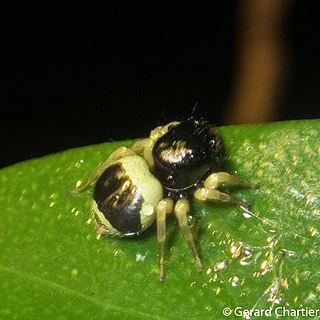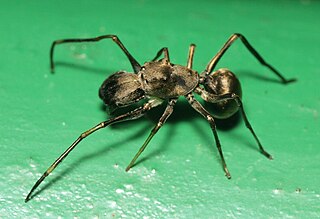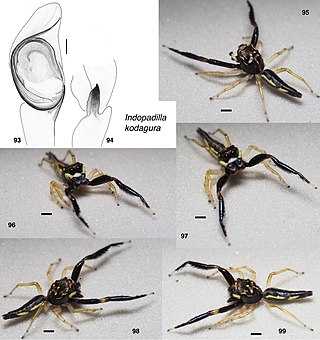
Attulus is a genus of jumping spiders that was first described by Eugène Louis Simon in 1889. The name is a diminutive form of a common prefix for salticid genera, -attus.

Omoedus is a genus of jumping spiders.

Pystira is a genus of spiders in the jumping spider family Salticidae.

Euophryini is a tribe of jumping spiders. It has also been treated as the subfamily Euophryinae.
Aelurillina is a subtribe of jumping spiders. Nearly all species live in the Old World, except Phlegra hentzi.

Attulus saltator is a species of jumping spider, from the Sitticinae subfamily. It was first described by Frederick Octavius Pickard-Cambridge in 1868 and has a Palearctic distribution, including Great Britain.

Attulus inexpectus is a species of spider from family Salticidae, found in from Europe to central Asia. It was previously misidentified as Attulus rupicola.
Hermosa is a genus of jumping spiders first described by G. W. Peckham and E. G. Peckham in 1892, and synonymized with Myrmarachne in 1901. In 2016, Jerzy Prószyński split up Myrmarachne, creating nine new genera, all with names beginning "Myrm". However, it turned out that Myrmavola volatilis, the type species of Myrmavola, was also the type species of Hermosa, and Myrmavola was made a junior synonym. It is part of the Myrmarachnini tribe within the Salticoida clade of Salticinae.
Nepalicius is a genus of spiders in the family Salticidae. It was first described in 2016 by Prószyński. As of 2017, it contains 3 species.
Okinawicius is a genus of spiders in the family Salticidae. It was first described in 2016 by Prószyński. As of 2017, it contains 9 species.
Psenuc is a genus of spiders in the family Salticidae. It was first described in 2016 by Prószyński. As of 2017, it contains 11 species.
Orcevia is a genus of Asian jumping spiders first described by Tamerlan Thorell in 1890. Laufeia, circumscribed to include Orcevia, is placed in the tribe Euophryini in the Salticoida clade of Salticinae. It was once considered a synonym of Laufeia, but it was revalidated in 2019.

Attinella is a genus of North American jumping spiders. It was first described by Nathan Banks in 1905 based on the type species Attinella dorsata. As of March 2022 it contains only three species: A. concolor, A. dorsata, and A. juniperi. It was synonymized with Sitticus from 1979 to 2017, when the genus Sittiab was split from Sitticus by Prószyński in 2017, and Attinella was recognized as its senior synonym.

Sittisax is a genus of spiders in the family Salticidae.

Toxeus is a genus of jumping spiders first described by Carl Ludwig Koch in 1846. The genus was synonymized with Myrmarachne by Eugène Simon in 1901, and remained a synonym until revived by Jerzy Prószyński in 2016, when he split up Myrmarachne.
Padillothorus is a genus of jumping spiders in the family Salticidae containing the single species, Padillothorus elegans. It was first described by Jerzy Prószyński in 2018, and has only been found in Indonesia.
Padillothorax is a genus of southeastern Asian jumping spiders first described by Eugène Simon in 1901. As of April 2019 it contains only two species.

Amycoida is an unranked clade of the jumping spider family Salticidae. It is the smaller and less widespread of the two subdivisions of the "typical" jumping spiders, occurring mainly in the New World, particularly the Amazon basin. Its sister clade is the Salticoida.

Indopadilla is a genus of jumping spiders first described by J. T. D. Caleb, P. M. Sankaran and K. S. Nafin in 2019. It was placed into the tribe Baviini in the Salticoida clade of Salticinae. Several species have been transferred from the genus Bavia.










